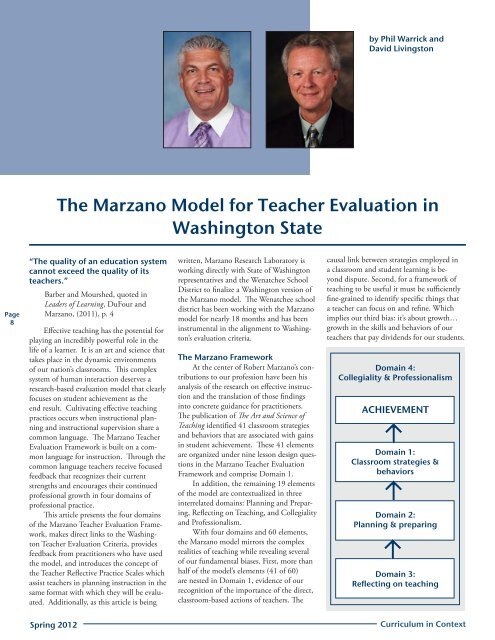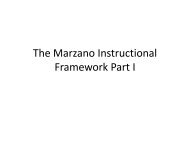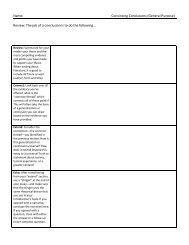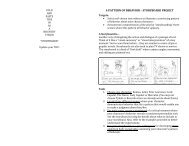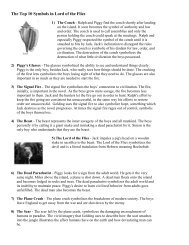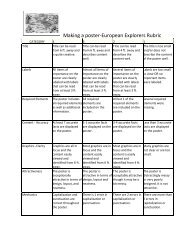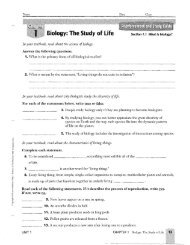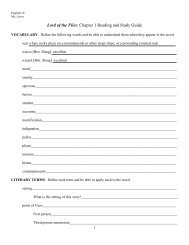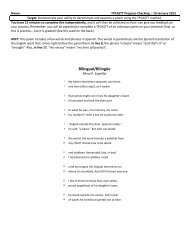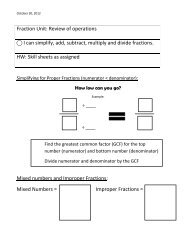The Marzano Model for Teacher Evaluation in Washington ... - wsascd
The Marzano Model for Teacher Evaluation in Washington ... - wsascd
The Marzano Model for Teacher Evaluation in Washington ... - wsascd
Create successful ePaper yourself
Turn your PDF publications into a flip-book with our unique Google optimized e-Paper software.
Page<br />
8<br />
<strong>The</strong> <strong>Marzano</strong> <strong>Model</strong> <strong>for</strong> <strong>Teacher</strong> <strong>Evaluation</strong> <strong>in</strong><br />
Wash<strong>in</strong>gton State<br />
“<strong>The</strong> quality of an education system<br />
cannot exceed the quality of its<br />
teachers.”<br />
Barber and Mourshed, quoted <strong>in</strong><br />
Leaders of Learn<strong>in</strong>g, DuFour and<br />
<strong>Marzano</strong>, (2011), p. 4<br />
Effective teach<strong>in</strong>g has the potential <strong>for</strong><br />
play<strong>in</strong>g an <strong>in</strong>credibly powerful role <strong>in</strong> the<br />
life of a learner. It is an art and science that<br />
takes place <strong>in</strong> the dynamic environments<br />
of our nation’s classrooms. This complex<br />
system of human <strong>in</strong>teraction deserves a<br />
research-based evaluation model that clearly<br />
focuses on student achievement as the<br />
end result. Cultivat<strong>in</strong>g effective teach<strong>in</strong>g<br />
practices occurs when <strong>in</strong>structional plann<strong>in</strong>g<br />
and <strong>in</strong>structional supervision share a<br />
common language. <strong>The</strong> <strong>Marzano</strong> <strong>Teacher</strong><br />
<strong>Evaluation</strong> Framework is built on a common<br />
language <strong>for</strong> <strong>in</strong>struction. Through the<br />
common language teachers receive focused<br />
feedback that recognizes their current<br />
strengths and encourages their cont<strong>in</strong>ued<br />
professional growth <strong>in</strong> four doma<strong>in</strong>s of<br />
professional practice.<br />
This article presents the four doma<strong>in</strong>s<br />
of the <strong>Marzano</strong> <strong>Teacher</strong> <strong>Evaluation</strong> Framework,<br />
makes direct l<strong>in</strong>ks to the Wash<strong>in</strong>gton<br />
<strong>Teacher</strong> <strong>Evaluation</strong> Criteria, provides<br />
feedback from practitioners who have used<br />
the model, and <strong>in</strong>troduces the concept of<br />
the <strong>Teacher</strong> Reflective Practice Scales which<br />
assist teachers <strong>in</strong> plann<strong>in</strong>g <strong>in</strong>struction <strong>in</strong> the<br />
same <strong>for</strong>mat with which they will be evaluated.<br />
Additionally, as this article is be<strong>in</strong>g<br />
written, <strong>Marzano</strong> Research Laboratory is<br />
work<strong>in</strong>g directly with State of Wash<strong>in</strong>gton<br />
representatives and the Wenatchee School<br />
District to f<strong>in</strong>alize a Wash<strong>in</strong>gton version of<br />
the <strong>Marzano</strong> model. <strong>The</strong> Wenatchee school<br />
district has been work<strong>in</strong>g with the <strong>Marzano</strong><br />
model <strong>for</strong> nearly 18 months and has been<br />
<strong>in</strong>strumental <strong>in</strong> the alignment to Wash<strong>in</strong>gton’s<br />
evaluation criteria.<br />
<strong>The</strong> <strong>Marzano</strong> Framework<br />
At the center of Robert <strong>Marzano</strong>’s contributions<br />
to our profession have been his<br />
analysis of the research on effective <strong>in</strong>struction<br />
and the translation of those f<strong>in</strong>d<strong>in</strong>gs<br />
<strong>in</strong>to concrete guidance <strong>for</strong> practitioners.<br />
<strong>The</strong> publication of <strong>The</strong> Art and Science of<br />
Teach<strong>in</strong>g identified 41 classroom strategies<br />
and behaviors that are associated with ga<strong>in</strong>s<br />
<strong>in</strong> student achievement. <strong>The</strong>se 41 elements<br />
are organized under n<strong>in</strong>e lesson design questions<br />
<strong>in</strong> the <strong>Marzano</strong> <strong>Teacher</strong> <strong>Evaluation</strong><br />
Framework and comprise Doma<strong>in</strong> 1.<br />
In addition, the rema<strong>in</strong><strong>in</strong>g 19 elements<br />
of the model are contextualized <strong>in</strong> three<br />
<strong>in</strong>terrelated doma<strong>in</strong>s: Plann<strong>in</strong>g and Prepar<strong>in</strong>g,<br />
Reflect<strong>in</strong>g on Teach<strong>in</strong>g, and Collegiality<br />
and Professionalism.<br />
With four doma<strong>in</strong>s and 60 elements,<br />
the <strong>Marzano</strong> model mirrors the complex<br />
realities of teach<strong>in</strong>g while reveal<strong>in</strong>g several<br />
of our fundamental biases. First, more than<br />
half of the model’s elements (41 of 60)<br />
are nested <strong>in</strong> Doma<strong>in</strong> 1, evidence of our<br />
recognition of the importance of the direct,<br />
classroom-based actions of teachers. <strong>The</strong><br />
by Phil Warrick and<br />
David Liv<strong>in</strong>gston<br />
causal l<strong>in</strong>k between strategies employed <strong>in</strong><br />
a classroom and student learn<strong>in</strong>g is beyond<br />
dispute. Second, <strong>for</strong> a framework of<br />
teach<strong>in</strong>g to be useful it must be sufficiently<br />
f<strong>in</strong>e-gra<strong>in</strong>ed to identify specific th<strong>in</strong>gs that<br />
a teacher can focus on and ref<strong>in</strong>e. Which<br />
implies our third bias: it’s about growth…<br />
growth <strong>in</strong> the skills and behaviors of our<br />
teachers that pay dividends <strong>for</strong> our students.<br />
Doma<strong>in</strong> 4:<br />
Collegiality & Professionalism<br />
ACHIEVEMENT<br />
Doma<strong>in</strong> 1:<br />
Classroom strategies &<br />
behaviors<br />
Doma<strong>in</strong> 2:<br />
Plann<strong>in</strong>g & prepar<strong>in</strong>g<br />
Doma<strong>in</strong> 3:<br />
Reflect<strong>in</strong>g on teach<strong>in</strong>g<br />
Spr<strong>in</strong>g 2012 Curriculum <strong>in</strong> Context
Doma<strong>in</strong> 1: Classroom Strategies and<br />
Behaviors<br />
This is the doma<strong>in</strong> that directly addresses<br />
what teachers do <strong>in</strong> classrooms. In<br />
the <strong>Marzano</strong> Framework the 9 design questions<br />
and 41 elements, drawn from <strong>The</strong> Art<br />
and Science of Teach<strong>in</strong>g, are organized under<br />
three general types of lesson segments. A<br />
lesson segment is an event <strong>in</strong> the classroom<br />
with strategies employed that are designed<br />
to meet a specific learn<strong>in</strong>g purpose. We<br />
use the concept of lesson segments to serve<br />
as a unit of analysis and provide focused<br />
feedback to teachers. In the follow<strong>in</strong>g we<br />
address each of the three lesson segments <strong>in</strong><br />
turn, although it is important to note they<br />
are not l<strong>in</strong>ear.<br />
“Rout<strong>in</strong>e segments” are strategies that<br />
<strong>in</strong>clude communicat<strong>in</strong>g learn<strong>in</strong>g goals,<br />
track<strong>in</strong>g student progress, celebrat<strong>in</strong>g the<br />
learn<strong>in</strong>g successes of <strong>in</strong>dividual students and<br />
whole classes, and the establishment and<br />
ma<strong>in</strong>tenance of productive rout<strong>in</strong>es <strong>in</strong>clud<strong>in</strong>g<br />
the physical layout of the classroom.<br />
“Content specific segments” are precisely<br />
that; th<strong>in</strong>gs that teachers do to help<br />
students successfully <strong>in</strong>teract with content.<br />
<strong>The</strong> <strong>Marzano</strong> model conta<strong>in</strong>s three specific<br />
situations <strong>for</strong> teach<strong>in</strong>g content: 1. Introduc<strong>in</strong>g<br />
new content, 2. Hav<strong>in</strong>g students practice<br />
and deepen their knowledge, or 3. Hav<strong>in</strong>g<br />
students generate and test hypotheses<br />
us<strong>in</strong>g what they have learned. Depend<strong>in</strong>g<br />
on which of these three specific situations is<br />
<strong>in</strong> play, teachers use different strategies that<br />
are clearly reflected <strong>in</strong> the model. <strong>The</strong>se<br />
specific content situations represent <strong>The</strong> Art<br />
and Science of Teach<strong>in</strong>g’s Design Questions 2,<br />
3, and 4.<br />
“Lesson segments enacted on the spot”<br />
is the f<strong>in</strong>al of the three segment categories.<br />
<strong>The</strong>se are strategies that might not be a<br />
part of every lesson but when called <strong>for</strong> a<br />
teacher must attend to them or the learn<strong>in</strong>g<br />
environment is at risk. <strong>The</strong>y are elements<br />
that teachers need to be prepared to use at a<br />
moment’s notice. When we look at the specifics<br />
of these elements they reflect research<br />
about student engagement; what we do to<br />
acknowledge when students are adher<strong>in</strong>g, or<br />
not adher<strong>in</strong>g, to established classroom rules<br />
and procedures; establish<strong>in</strong>g and ma<strong>in</strong>ta<strong>in</strong><br />
effective relationships with students; and<br />
communicat<strong>in</strong>g high expectations <strong>for</strong> all<br />
students…especially those <strong>for</strong> whom school<br />
success is an elusive target.<br />
Exam<strong>in</strong><strong>in</strong>g <strong>The</strong> State of Wash<strong>in</strong>gton’s<br />
new evaluation criteria <strong>for</strong> teach<strong>in</strong>g reveals<br />
that the three lesson segments of Doma<strong>in</strong> 1<br />
of the <strong>Marzano</strong> Framework specifically align<br />
with three of the new criteria: WA Criterion<br />
1: Center<strong>in</strong>g <strong>in</strong>struction on high expectations<br />
<strong>for</strong> student achievement; WA Criterion 2:<br />
Demonstrat<strong>in</strong>g research-based <strong>in</strong>structional<br />
practices; and WA Criterion 5: Provid<strong>in</strong>g a<br />
safe, <strong>in</strong>clusive learn<strong>in</strong>g environment.<br />
Feedback from practitioners has re<strong>in</strong><strong>for</strong>ced<br />
the value of the more specific and<br />
focused feedback that teachers receive <strong>in</strong><br />
the strategies and behaviors of Doma<strong>in</strong> 1.<br />
One assistant pr<strong>in</strong>cipal us<strong>in</strong>g the framework<br />
<strong>in</strong>dicated the feedback she can provide to<br />
all teachers has been more focused and of<br />
higher quality. She related examples of<br />
provid<strong>in</strong>g quality feedback to very successful<br />
teachers. Instead of say<strong>in</strong>g th<strong>in</strong>gs like “you<br />
are such an awesome teacher,” she now is<br />
able to po<strong>in</strong>t out that the teacher’s classroom<br />
pac<strong>in</strong>g when deliver<strong>in</strong>g new content<br />
is well planned. Thus, allow<strong>in</strong>g her to<br />
re<strong>in</strong><strong>for</strong>ce specific elements where a teacher is<br />
do<strong>in</strong>g a good job and demonstrat<strong>in</strong>g model<br />
practices.<br />
In us<strong>in</strong>g the <strong>Marzano</strong> model <strong>in</strong> a large<br />
suburban high school, I (Phil Warrick)<br />
found that when work<strong>in</strong>g with teachers <strong>in</strong><br />
need of improvement, the lesson segments<br />
and specific behaviors with<strong>in</strong> each segment<br />
helped our adm<strong>in</strong>istrative team provide the<br />
specific focus and feedback necessary <strong>for</strong><br />
<strong>in</strong>struction to improve. Add to this process<br />
the teacher reflective practice scales, and<br />
the conditions <strong>for</strong> improvement are clear,<br />
concise, and atta<strong>in</strong>able.<br />
Doma<strong>in</strong> 2: Plann<strong>in</strong>g and Prepar<strong>in</strong>g<br />
Central to an understand<strong>in</strong>g of the<br />
<strong>Marzano</strong> Framework is the <strong>in</strong>fluential<br />
relationship that a teacher’s plann<strong>in</strong>g has on<br />
the classroom strategies employed when it’s<br />
time to teach. Impactful teach<strong>in</strong>g has never<br />
been a matter of w<strong>in</strong>g<strong>in</strong>g it. When we talk<br />
about plann<strong>in</strong>g we mean the plann<strong>in</strong>g it<br />
takes to ensure the effective scaffold<strong>in</strong>g of<br />
<strong>in</strong><strong>for</strong>mation with<strong>in</strong> lessons, the logical and<br />
mean<strong>in</strong>gful progression of lessons with<strong>in</strong><br />
units, and the attention a teacher must pay<br />
to the established content standards of districts<br />
and states. Furthermore, that plann<strong>in</strong>g<br />
must be understood to <strong>in</strong>clude the thoughtful<br />
and effective use of available materials<br />
and technologies that can enhance students’<br />
understand<strong>in</strong>g of the content <strong>in</strong> a given lesson<br />
or unit.<br />
Because the learn<strong>in</strong>g needs of students<br />
are as <strong>in</strong>dividual as the students themselves,<br />
it is essential to identify the support that<br />
three specific sub-populations of students<br />
may require. First, as the population of<br />
English language learners grows <strong>in</strong> many of<br />
our schools, teachers are called on to th<strong>in</strong>k<br />
ahead about the adaptations that must be<br />
made <strong>for</strong> those learners. Second, there are<br />
few if any classrooms <strong>in</strong> America that don’t<br />
need to serve the needs of special education<br />
students. <strong>The</strong> critical support that special<br />
educators provide does not supplant the<br />
<strong>in</strong>structional adaptations that regular education<br />
teachers must be prepared to make.<br />
And third, when students come from home<br />
environments that offer limited support <strong>for</strong><br />
school<strong>in</strong>g, teachers must plan supportive<br />
approaches <strong>for</strong> students with few material or<br />
psychological resources to draw on outside<br />
of school.<br />
<strong>The</strong>se three elements of Doma<strong>in</strong> 2,<br />
plann<strong>in</strong>g and prepar<strong>in</strong>g <strong>for</strong> lessons and<br />
<strong>The</strong> State of Wash<strong>in</strong>gton’s <strong>Teacher</strong> <strong>Evaluation</strong> Criteria<br />
per E2SSB 6696<br />
#1 – Center<strong>in</strong>g <strong>in</strong>struction on high expectations <strong>for</strong> student achievement<br />
#2 – Demonstrat<strong>in</strong>g research-based <strong>in</strong>structional practices<br />
#3 – Address<strong>in</strong>g the needs of <strong>in</strong>dividual students<br />
#4 – Focus<strong>in</strong>g on subject matter content and curriculum<br />
#5 – Provid<strong>in</strong>g a safe, <strong>in</strong>clusive learn<strong>in</strong>g environment<br />
#6 – Us<strong>in</strong>g student data to modify <strong>in</strong>struction and improve student<br />
learn<strong>in</strong>g<br />
#7 – Communicat<strong>in</strong>g and collaborat<strong>in</strong>g with families and communities<br />
#8 – Utiliz<strong>in</strong>g collegial collaboration to improve practice and advance<br />
student learn<strong>in</strong>g<br />
Curriculum <strong>in</strong> Context Spr<strong>in</strong>g 2012<br />
Page<br />
9
Page<br />
10<br />
units, <strong>for</strong> the use of materials and technologies,<br />
and <strong>for</strong> the special needs of students<br />
speak directly to WA Criterion #3: Address<strong>in</strong>g<br />
the needs of <strong>in</strong>dividual students; and<br />
WA Criterion #4: Focus<strong>in</strong>g on subject matter<br />
content and curriculum.<br />
Doma<strong>in</strong> 3: Reflect<strong>in</strong>g on Teach<strong>in</strong>g<br />
A case could be made that the State of<br />
Wash<strong>in</strong>gton’s <strong>in</strong>tent to re<strong>for</strong>m current teacher<br />
evaluation practices is significantly realized<br />
<strong>in</strong> the fulfillment of the two elements<br />
of Doma<strong>in</strong> 3: evaluat<strong>in</strong>g personal per<strong>for</strong>mance<br />
and develop<strong>in</strong>g and implement<strong>in</strong>g a<br />
professional growth plan. When fulfilled <strong>in</strong><br />
their logical sequence, the central role that a<br />
teacher will play <strong>in</strong> be<strong>in</strong>g responsible <strong>for</strong> his<br />
or her own professional growth could not be<br />
more clear. A teacher who is able to evaluate<br />
his or her per<strong>for</strong>mance has taken a giant first<br />
step toward ever-<strong>in</strong>creas<strong>in</strong>g effectiveness.<br />
<strong>Marzano</strong>’s “<strong>Teacher</strong> Scales <strong>for</strong> Reflective<br />
Practice: Doma<strong>in</strong> I” ( marzanoresearch.com<br />
offers a free download) <strong>in</strong>vites a teacher to<br />
exam<strong>in</strong>e the 41 elements of Doma<strong>in</strong> I of the<br />
framework and then use a scale to rate his<br />
or her present skillfulness <strong>in</strong> the utilization<br />
of each one. <strong>The</strong> <strong>for</strong>mat of the scales <strong>for</strong><br />
Doma<strong>in</strong> 1 helps avoid the simplistic trap of<br />
some self-assessment and feedback protocols<br />
that devolve <strong>in</strong>to checklists of strategies<br />
be<strong>in</strong>g used or not used. <strong>The</strong> values from the<br />
<strong>Marzano</strong> <strong>Teacher</strong> Reflective scales are:<br />
• Innovat<strong>in</strong>g (4) – Adapts and creates<br />
new strategies <strong>for</strong> unique student needs<br />
and situations<br />
• Apply<strong>in</strong>g (3) – Engages students <strong>in</strong><br />
the strategy and monitors the extent to<br />
which it produces the desired outcomes<br />
• Develop<strong>in</strong>g (2) – Engages students <strong>in</strong><br />
the strategy with no significant errors or<br />
omissions<br />
• Beg<strong>in</strong>n<strong>in</strong>g (1) – Uses the strategy <strong>in</strong>correctly<br />
or with parts miss<strong>in</strong>g<br />
• Not Us<strong>in</strong>g (0) – Strategy was called <strong>for</strong><br />
but not exhibited<br />
<strong>The</strong> scales <strong>for</strong> Doma<strong>in</strong>s 2, 3, and 4 are<br />
<strong>in</strong> a <strong>for</strong>mat that parallel those of Doma<strong>in</strong> I<br />
and can be found at marzanoresearch.com<br />
> Services > <strong>Teacher</strong> <strong>Evaluation</strong> <strong>Model</strong> –<br />
Resources, on pp. 40-48 of the “<strong>Marzano</strong><br />
<strong>Teacher</strong> <strong>Evaluation</strong> Scales.”<br />
Ultimately a teacher’s self-evaluation<br />
must translate <strong>in</strong>to systemic action, and a<br />
vehicle <strong>for</strong> such action is a plan <strong>for</strong> professional<br />
growth and development. For<br />
a mean<strong>in</strong>gful and manageable annual<br />
professional growth plan, we advocate that<br />
a teacher select two or three elements from<br />
Doma<strong>in</strong> 1 and another several from Doma<strong>in</strong>s<br />
2-4, as targets <strong>for</strong> focus and improvement.<br />
<strong>The</strong> selection process will, of course,<br />
draw heavily on the teacher’s own self-reflection,<br />
but done <strong>in</strong> consultation with that<br />
teacher’s supervisor.<br />
Expectations <strong>for</strong> the creation of these<br />
k<strong>in</strong>ds of plans are typical <strong>in</strong> current practice.<br />
But <strong>in</strong> our framework a teacher monitors<br />
the extent to which goals are be<strong>in</strong>g accomplished<br />
and charts his or her progress on<br />
both the identified <strong>in</strong>structional strategies<br />
and the accompany<strong>in</strong>g student learn<strong>in</strong>g<br />
ga<strong>in</strong>s. It is <strong>in</strong> this consistent and frequent<br />
monitor<strong>in</strong>g that both the purpose and profit<br />
of growth plann<strong>in</strong>g comes to life.<br />
<strong>The</strong> elements of Doma<strong>in</strong> 3 align with<br />
parts of three of Wash<strong>in</strong>gton’s new criteria:<br />
WA Criterion #2: Demonstrat<strong>in</strong>g researchbased<br />
<strong>in</strong>structional practices; WA Criterion #6:<br />
Us<strong>in</strong>g student data to modify <strong>in</strong>struction and<br />
improve student learn<strong>in</strong>g; and WA Criterion<br />
#8: Utiliz<strong>in</strong>g collegial collaboration to improve<br />
practice and advance student learn<strong>in</strong>g.<br />
Doma<strong>in</strong> 4: Collegiality and<br />
Professionalism<br />
This doma<strong>in</strong> is not directly related to<br />
growth <strong>in</strong> classroom strategies and behaviors,<br />
but it is the context <strong>in</strong> which the other<br />
doma<strong>in</strong>s function. In a school or district,<br />
high levels of collegiality and professionalism<br />
can significantly enhance Doma<strong>in</strong>s 1,<br />
2, and 3.<br />
Doma<strong>in</strong> 4 <strong>in</strong>cludes three elements:<br />
promot<strong>in</strong>g a positive environment, promot<strong>in</strong>g<br />
the free and open exchange of ideas and<br />
strategies, and promot<strong>in</strong>g district and school<br />
development. In the <strong>Marzano</strong> Framework,<br />
it is the elements and actions of Doma<strong>in</strong><br />
4 that specifically address WA Criterion<br />
#7: Communicat<strong>in</strong>g and collaborat<strong>in</strong>g with<br />
parents and communities, and WA Criterion<br />
#8: Utiliz<strong>in</strong>g collegial collaboration to improve<br />
practice and advance student learn<strong>in</strong>g.<br />
Chang<strong>in</strong>g the Conversation:<br />
Collaboration <strong>for</strong> <strong>Teacher</strong><br />
Effectiveness<br />
For years, <strong>in</strong>structional evaluators<br />
have been search<strong>in</strong>g <strong>for</strong> better tools to help<br />
them assess, provide feedback, and foster<br />
teacher pedagogy. <strong>The</strong> <strong>Marzano</strong> model<br />
provides these tools with<strong>in</strong> the framework<br />
of a research-based common language <strong>for</strong><br />
<strong>in</strong>struction. By clearly def<strong>in</strong><strong>in</strong>g 60 effective<br />
teach<strong>in</strong>g behaviors across four doma<strong>in</strong>s of<br />
professional practice, the <strong>Marzano</strong> model<br />
offers a user-friendly, common language<br />
<strong>for</strong> all educators. With<strong>in</strong> the <strong>Marzano</strong><br />
model, 41 of the 60 elements are specifically<br />
focused on classroom practices and come<br />
directly from the body of research presented<br />
<strong>in</strong> <strong>The</strong> Art and Science of Teach<strong>in</strong>g. Additionally,<br />
numerous free resources to support<br />
the use of the <strong>Marzano</strong> model are available<br />
on the <strong>Marzano</strong> Research Laboratory web<br />
site. <strong>Marzano</strong> Research Laboratory has also<br />
developed two new publications to support<br />
teacher growth. <strong>The</strong>se are Becom<strong>in</strong>g a Reflective<br />
<strong>Teacher</strong> and Coach<strong>in</strong>g Teach<strong>in</strong>g.<br />
For more <strong>in</strong><strong>for</strong>mation about the<br />
<strong>Marzano</strong> <strong>Teacher</strong> <strong>Evaluation</strong> model <strong>in</strong> the<br />
state of Wash<strong>in</strong>gton, please email either of<br />
the authors of this article: phil.warrick@<br />
marzanoresearch.com or david.liv<strong>in</strong>gston@<br />
marzanoresearch.com<br />
References<br />
DuFour, R. & <strong>Marzano</strong>, R. J. (2011). Leaders of<br />
learn<strong>in</strong>g: How district, school, and classroom<br />
leaders improve student achievement. Bloom<strong>in</strong>gton,<br />
IN: Solution<br />
Tree Press.<br />
<strong>Marzano</strong>, R. J. (2007). <strong>The</strong> Art and Science of<br />
Teach<strong>in</strong>g: A comprehensive framework <strong>for</strong><br />
effective <strong>in</strong>struction. Alexandria, VA: Association<br />
<strong>for</strong> Supervision and Curriculum Development.<br />
<strong>Marzano</strong>, R. J., Frontier, A., and Liv<strong>in</strong>gston, D.<br />
(2011). Effective Supervision: Support<strong>in</strong>g the<br />
art and science of teach<strong>in</strong>g. Alexandria, VA:<br />
ASCD.<br />
Phil Warrick, Ed. D. jo<strong>in</strong>ed <strong>Marzano</strong> Research<br />
Laboratory <strong>in</strong> July of 2011 as a national tra<strong>in</strong>er<br />
and Associate Vice President. Dr. Warrick spent<br />
24 years work<strong>in</strong>g <strong>in</strong> public education <strong>in</strong>clud<strong>in</strong>g<br />
14 as an adm<strong>in</strong>istrator. In 2005 he was<br />
selected as the Nebraska High School Pr<strong>in</strong>cipal<br />
of the Year. In 2008 he accepted the position of<br />
Campus Pr<strong>in</strong>cipal at Round Rock High School <strong>in</strong><br />
Round Rock, TX where he led the implementation<br />
of <strong>The</strong> Art and Science of Teach<strong>in</strong>g and<br />
the <strong>Marzano</strong> Observation Protocol <strong>for</strong> teacher<br />
evaluation.<br />
David Liv<strong>in</strong>gston, Ph.D., jo<strong>in</strong>ed <strong>Marzano</strong> Research<br />
Laboratory <strong>in</strong> the fall of 2008. His public<br />
school career spanned 37 years and <strong>in</strong>cluded<br />
ten years of classroom teach<strong>in</strong>g, 20 years serv<strong>in</strong>g<br />
as pr<strong>in</strong>cipal of four schools, and from 1998<br />
to 2005 he was Executive Director of Elementary<br />
Education <strong>for</strong> the Cherry Creek Schools, CO.<br />
David is coauthor with Robert <strong>Marzano</strong> and<br />
Tony Frontier of Effective Supervision: Support<strong>in</strong>g<br />
the Art and Science of Teach<strong>in</strong>g, published<br />
by ASCD <strong>in</strong> 2011.<br />
Spr<strong>in</strong>g 2012 Curriculum <strong>in</strong> Context


